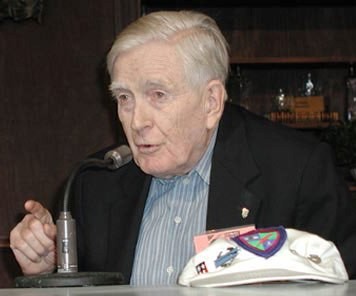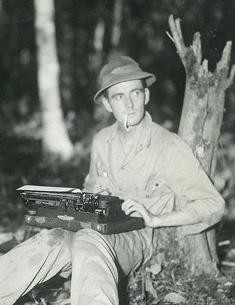Foreign Correspondent’s Career Spanned the World and War
By Matt Schudel
Courtesy of the Washington Post
Sunday, January 30, 2005
The first American soldiers to fight on the Asian mainland during World War II were a remarkable band of roughnecks known as Merrill’s Marauders. The volunteer commando unit, which had more than a few misfits and rogues in its ranks, marched into action in Burma in 1944.
Its mission was to hack its way through roadless jungles in Burma, raiding Japanese supply lines and troops along the way, and to seize an airport in the Burmese city of Myitkyina. One member of its 3,000-man force was a soldier scribe named David B. Richardson, a technical sergeant who had initially been rejected by the Army for being underweight.
Richardson in New Guinea in 1943.
As a correspondent for Yank, a magazine for enlisted men, he chronicled the exploits of Merrill’s Marauders in 1944, armed with a typewriter, a camera and a rifle.
It was Richardson’s job as a correspondent for Yank, a weekly magazine for enlisted men, to chronicle the four-month march of Merrill’s Marauders, known officially as the 5307th Composite Unit (Provisional). By mission’s end, only 200 men were still in fighting trim, with the remainder killed, wounded or, in most cases, evacuated because of sickness and insect-borne disease.
By then, the Marauders, named for their commanding officer, Brigadier General Frank Merrill, were a storied fighting force. Slogging 1,000 miles on foot through dense foliage, over mountains and across rivers, they won five major battles and 30 skirmishes, despite being vastly outnumbered by elite Japanese troops.
Richardson walked every step of the way with the Marauders, writing his accounts in the face of bullets and with the cries of the dying in his ears.
“The stuff he wrote was like what no one else was doing,” said David Quaid, a cameraman who was attached to the Marauders. “When it got dicey, the only correspondent there was Dave Richardson.”
Richardson, who died January 25, 2005, of prostate cancer at 88 at his home in Washington, went on to have a long and distinguished career as a foreign correspondent for Time, Life and U.S. News & World Report. He opened Time’s first postwar bureau in Germany; he witnessed the peaceful revolution of Mohandas Gandhi in India; he was in Cairo the day King Farouk was overthrown in 1952; he covered military coups across South America; he interviewed world leaders, including Ethiopia’s Haile Selassie, Israel’s Menachem Begin and Libya’s Moammar Gaddafi. In a Mexican prison, he met the man who killed Leon Trotsky.
Before retiring in 1982, Richardson worked on six of the seven continents. The New Jersey native was a reporter before World War II, but his grand adventure really began when he enlisted in the Army and was assigned to Yank.
Instead of sitting in an office in Australia, he volunteered to observe the war from the GI’s point of view. That’s how he found himself in battle in New Guinea, carrying a typewriter, a camera and a rifle.
“No matter where you looked,” an Army officer later wrote of Richardson, “the redhead was there.”
He volunteered for a flight on a B-24 over the Pacific, only to find himself manning a .50-caliber machine gun when the bomber was attacked by Japanese fighter planes. He was aboard a PT boat that was engaged in a nighttime gun battle.
He was the machine gunner in the nose of the first American tank to enter Burma. He parachuted behind enemy lines to meet agents with the Office of Strategic Services — the forerunner of the CIA — training Burmese guerrillas.
“I decided the best way to lessen fear in the heat of action was to keep busy,” Richardson wrote later. “And what better way to keep busy than by joining in the shooting? So I began to seek out regular combat duties in every operation I covered.”
Nothing kept him busier than his heroic trek with Merrill’s Marauders, who endured the longest marches and most sustained fighting of any American units in World War II. In an article about a particularly tough squad known as the Dead End Kids, Richardson captured the flavor of battle, as well as the Marauders’ jingoistic pride and derring-do:
“Then, as suddenly as the morning attack had ceased, the dusk battle halted. Both sides stopped firing. The silence was broken by a Dead End Kid who rose to his feet on the river bank, cupped his hands to his mouth and yelled: ‘Come on. . . . Come and get your lead!’ ”
After the war, the editor of Yank wrote, “Richardson was remarkable among soldier reporters, in that he actually used weapons and made himself a valuable and welcomed member of whatever unit he was writing about.”
Richardson is believed to be the most highly decorated correspondent in uniform during World War II, having received the Legion of Merit, two Bronze Stars, two Presidential Unit Citations and the Combat Infantryman’s Badge. He missed receiving a Purple Heart in New Guinea because he refused to stay overnight in a hospital for treatment of a wound near his eye. Instead, he returned to action wearing an eye patch.
“He was a totally fearless guy,” said Quaid, who saw Richardson in action. “He was a remarkable man.”
Merrill’s Marauders completed their mission by seizing the airport at Myitkyina in May 1944, but Richardson’s war wasn’t over. For his final story, he accompanied the Gurkhas, a fierce fighting group from Nepal, as they parachuted into Rangoon and routed the last Japanese forces from the Burmese capital.
In a speech more than 50 years later, Richardson explained why he took such extraordinary risks. “Well,” he said, “for a good story.”

RICHARDSON, DAVID B.
On Tuesday, January 25, 2005 at his home in Washington, DC. Mr. Richardson was preceded in death by his first wife, Ruth Cummings Richardson. He is survived by his wife, Anne Werner Richardson; his daughters, Hilary C. Richardson, Julie Richardson and Francesca Richardson; and his granddaughters, Lydia and Claire Neilson.
A Memorial Service will be held at St. Alban’s Episcopal Church, 3001 Wisconsin Avenue, NW, Washington, DC on Wednesday, February 16 at 3 p.m. At a later date an interment ceremony will be held at Arlington National Cemetery. In lieu of flowers, contributions may be made in his name to Community Hospice of Washington, 3720 Upton Street, NW, Washington, DC 20016; St. Alban’s Episcopal Church; or Episcopal Senior Ministries, 900 Second Street, NE, Washington, DC 20002.
RICHARDSON, DAVID B
- TSGT US ARMY
- DATE OF BIRTH: 07/13/1916
- DATE OF DEATH: 01/25/2005
- BURIED AT: SECTION 2-K ROW 8 SITE 4
ARLINGTON NATIONAL CEMETERY
RICHARDSON, RUTH C
- DATE OF BIRTH: 03/13/1922
- DATE OF DEATH: 02/28/1987
- BURIED AT: SECTION 2-K ROW 8 SITE 4
ARLINGTON NATIONAL CEMETERY - WIFE OF RICHARDSON, DAVID B – TSGT US ARMY
Michael Robert Patterson was born in Arlington and is the son of a former officer of the US Army. So it was no wonder that sooner or later his interests drew him to American history and especially to American military history. Many of his articles can be found on renowned portals like the New York Times, Washingtonpost or Wikipedia.
Reviewed by: Michael Howard

